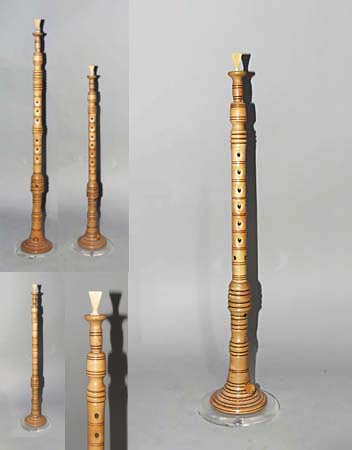
Owner: HWMC
Catalog#: 2CL-AERV-29
Woodwind - Double Reed
Croatian 'Sopila (or Roženice)' Double Reed 'Female' Horn
Croatia
Maker Unknown
Wood, cane reed
Early-Mid 20th century
Length: 18 in, Bell diameter: 3.5 in
Wind Instruments – Woodwinds – Double Reed
This light-colored wood sopila (or roženice, as it is called in Istria) is an ancient traditional woodwind instrument of Croatia, similar to the oboe or shawm. The sopila features double reeds and a conical bore, having a powerful sound. It has six finger holes and three whisper holes. There are darker incised rings along the entire length of the body and geometric ridged rings around the bell. A small wooden peg is stuck into a hole on the bell as well.
The sopila (or roženice, as it is called in Istria) is always played in pairs. The larger sopila, referred to as the “male” and of lower pitch, is accompanied by a smaller, “female” sopila, as seen here. Each sopila (or roženice) consists of 5 parts: Reed (double) – Pirouette (conical metal tube where the reed is inserted) – Chanter (tubing with drilled finger holes) – Bell (where chanter is inserted and serves to augment the sound – also has a vent hole) – Wooden Stop (located in bell to prevent the pirouette from falling off when not played) – Fontanelle (cylinder portion that surrounds the connection between the chanter and the bell).
The sopila (or roženice) plays the Istrian scale that is approximately notated as E-F-G-Ab-Bb-Cb (hexatonic). It is the first six notes of an octatonic scale on E, or the Gregorian Phrygian mode with lowered 4th, 5th, and 6th degrees (on E: E-F-G-Ab-Bb-Cb-D [heptatonic]). The scale has also been described as derived from ‘just intonation.’
When dancing and singing (usually in two-parts), the two sopile (plural of sopila) accompany the music playing the Istrian scale. The sopile (or roženices) are closely identified with the Croatian island of Krk but used throughout the Kvarner region, comprised of the islands and shorelines of the Gulf of Kvarner, the body of water between the Istrian peninsula and the mainland Croatian littoral.
Resource: https://artsandculture.google.com/story/a-play-for-two-croatian-national-tourist-board/ogUBvihR_PN5Jw?hl=en
